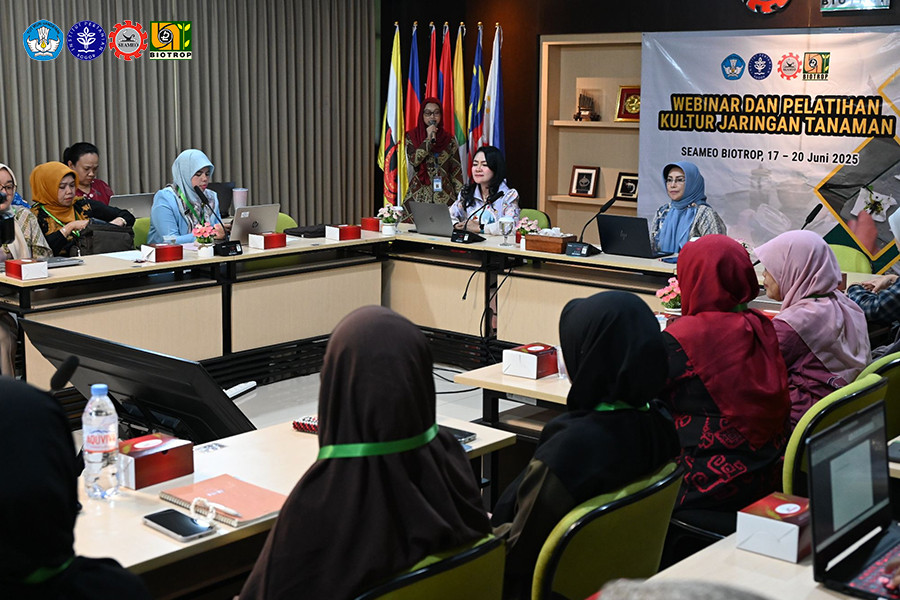Bogor, 17 June 2025 – SEAMEO BIOTROP (Southeast Asian Regional Centre for Tropical Biology), demonstrated its commitment to strengthening the capacity of Indonesian educators by organizing a webinar and Plant Tissue Culture Training. The event took place from June 17-20, 2025, in Bogor, West Java.
This activity is part of the tropical biodiversity conservation education program, which has become a priority for the institution in supporting the transformation of science and environmental education in Indonesia.
The Acting Director of SEAMEO BIOTROP, Elis Rosdiawati, emphasized in her speech that this activity is a strategy to strengthen laboratory-based knowledge transfer and conservation to teachers as agents of transformation. "We hope that the alumni of this training can encourage the formation of environmentally and tropical science-based schools," Elis stated.
On the same occasion, the representative from the Directorate of Secondary Education and Special Education Teachers, Kemendikdasmen, Nuril Furkan, also expressed appreciation for SEAMEO BIOTROP's role in providing knowledge to teachers. "Especially in providing learning and practical space for tropical biology technology, mainly regarding tissue culture techniques for teachers in Indonesia," he explained.
The activity, which began with a national webinar on Tuesday (June 17), was attended by approximately 300 participants from various backgrounds, including teachers, students, academics, and education industry players. Renowned plant biology experts presented, namely: 1) Amien Suseno from Universitas Padjadjaran; 2) Siti Halimah Larekeng from Universitas Hasanuddin; 3) Bambang Sapto Purwoko from IPB University; and 4) Dewi Suryani, Manager of the Human Centre & Innovation Department, SEAMEO BIOTROP.
The Deputy Director of Program at SEAMEO BIOTROP, Doni Yusri, who served as moderator, said that tropical biology is a bridge between science and conservation, and teachers are key in transforming this knowledge to the younger generation.
Offline training was also conducted to provide direct practical experience to 30 selected teachers from 27 schools at the SEAMEO BIOTROP Laboratory. The training materials covered the preparation of growing media, sterilization of forestry and horticulture plant explants, subculture, and plant acclimatization.
Each participant was required to prepare a real action plan as part of the training's sustainability strategy, which is a follow-up plan to be implemented in their respective schools. This real action also serves as a measure of training achievement and a reference for SEAMEO BIOTROP to monitor the impact of the activity at the educational unit level.
The components of the real action include: integration of tissue culture material into biology or agriculture learning, plans for practical work or student science projects based on tissue culture, development of a mini school laboratory (if possible), and school collaboration with other institutions in utilizing the training results.
Furthermore, in her session, Dewi Suryani discussed modern strategies for applying tissue culture to support sustainable agriculture and its application in schools and BIOTROP's teaching factory. She emphasized that this training aims to form a network of pioneering tropical biology teachers capable of developing learning innovations and encouraging the emergence of conservation-based schools.
Through this activity, it is hoped that a community of educators will emerge who can integrate biological knowledge and the spirit of conservation into the learning culture at schools. With a collaborative spirit and an action-based approach, this activity serves as a strategic step in strengthening teacher capacity and building a more adaptive, contextual, and sustainable Indonesian education system.
The training was also facilitated by SEAMEO BIOTROP's internal instructor team, consisting of Lillys Betty Yuliawati, Rosadi Kertawijaya, Agus Suryani, Dwi Cahyono, and Muhammad Yusuf. With the support of the teaching factory facilities, the training was packaged interactively through a combination of theory, laboratory practice, group discussions, and learning outcome evaluations.
 Friday, 20 June 2025 on 8:24pm
Friday, 20 June 2025 on 8:24pm
